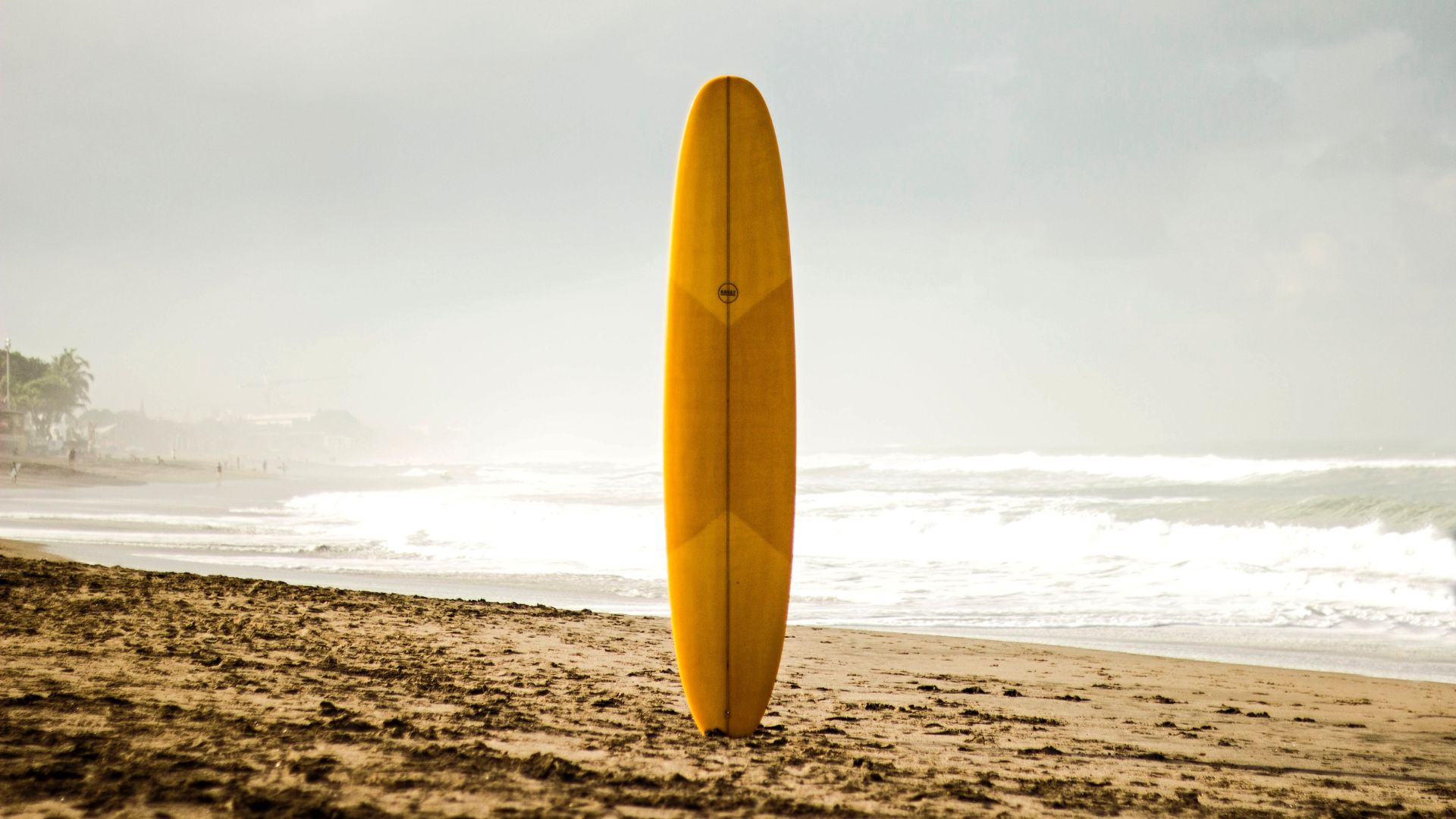Sun damage is one of the biggest frustrations with spending time outdoors.
Developing cancer or other skin conditions is a troubling ordeal for anyone affected.
Coping with damage, including cancer, is extremely frustrating. Deciding which route to go with traditional medicine or alternative treatments is a tough decision, as the subjects in the documentary The Cancer Conflict (on Prime Video) show.
Although sun exposure is damaging, you don’t need to fear the consequences of enjoying the surf for extended periods of time. Understanding how to protect yourself from the sun’s most harmful rays goes a long way toward keeping your skin healthy as you enjoy your time in the water.
In this article…
We explore the importance of protecting your skin while surfing and provide valuable tips to prevent sun damage, ensuring a safer and more enjoyable experience.
Understanding the Dangers of Sun Exposure in the Water
A common myth is that it’s impossible to get sunburned under the water.
Sunlight reflects off the water’s surface back into the atmosphere. However, sunlight can penetrate below the water’s surface, too.
The amount of light that penetrates water, especially when the water is clear, is greater than the amount reflected. This effect helps keep the water at consistently warm temperatures. The waters around Indonesia do not experience the seasonal temperature changes common in many other surfing areas.
The depths where sunlight can penetrate range to at least several feet, depending on the amount of cloud cover. On days with very intense sunlight, the light may easily reach six feet or more. The type of rays present on a sunny day may impact your sunburn risk, as well, with two types of rays being most likely to cause damage – UVA and UVB.
The Different Types of Ultraviolet (UV) Rays
Ultraviolet (UV) light is a type of radiation that is emitted by the sun. It is capable of sun damage, including burns.
The most dangerous types of rays are UVA rays. These rays can penetrate the skin to the middle layers, where they can cause some of the worst damage. These burns may require a longer recovery time because of the depth.
However, the rays most capable of penetrating areas where melanoma forms are UVB rays. Although many melanoma cases have excellent treatment success rates, some forms metastasize quickly, making sun protection all the more critical. Although UVB rays are most commonly associated with melanoma, UVA rays can also cause this type of cancer.
Protecting your skin when surfing will reduce your chances of skin cancer or other conditions originating from sun damage. You must be cautious about identifying areas most likely to get sunburn, especially if you have a history of problems with sunburn. Some areas most vulnerable to sun damage require extra care to prevent painful burns and reduce the overall risk of more serious damage.
Decoding UV-Induced Skin Aging
The impact of ultraviolet (UV) radiation on skin photoaging has been extensively studied, revealing several key factors that contribute to the aging process caused by sun exposure. One of the prominent effects is the thickening of the epidermis, the outermost layer of the skin. This thickening is accompanied by an increase in the activity of enzymes known as dermal elastases, which degrade elastin fibers in the skin, leading to loss of elasticity.
Furthermore, the amount of extracellular matrix (ECM) proteins, which are crucial for maintaining skin structure and firmness, decreases under the influence of UV radiation. This depletion of ECM proteins is exacerbated by the increased activity of matrix metalloproteinases (MMPs), enzymes that break down collagen and other components of the ECM. This ultimately results in the fragmentation of collagen fibers, further contributing to the loss of skin elasticity and the formation of wrinkles.
UV-induced skin damage
Inflammatory responses also play a significant role in UV-induced skin damage. Sun exposure triggers an increase in inflammatory infiltrates, causing chronic inflammation in the skin. This inflammation can lead to various detrimental effects, including the dilation of small blood vessels (telangiectasia) and the release of damaging free radicals.
Despite numerous studies conducted in this area, the exact mechanisms underlying these processes are not fully elucidated. However, it is widely accepted that DNA damage in skin cells is a pivotal event in the progression of photoaging. UV radiation can cause direct DNA damage, leading to mutations and other genetic alterations that contribute to the aging process.
Exploring Photoaging Mechanisms
Understanding the intricate mechanisms of photoaging is essential for identifying potential cosmetic ingredients that could offer protection against the harmful effects of UV radiation or assist in repairing the damage it causes. By gaining a deeper insight into the underlying processes, researchers can develop innovative skincare products that target these mechanisms and help maintain healthier, more youthful-looking skin.
Sun Safety for Surfers: Navigating UV Risks and Protection
Surfers are particularly vulnerable to sun damage due to their extended periods in direct sunlight and the reflective properties of water. The combination of UV radiation and water reflection can intensify the effects of sun exposure, making surfers more prone to burns and skin-related problems. Therefore, it’s crucial for surfers to adopt effective sun protection strategies to minimize these risks.

Areas Most Prone to Sunburn While Surfing
The parts of your body most likely to get sunburned while surfing are your…
- face
- shoulders
- top of your feet
- and backs of your calves.
When sunlight reflects off the water, any uncovered part of your body could experience sunburn.
Sun Protection Tips for Surfers
1. Choose the Right Sunscreen for Surfing
Sunscreen that is non-toxic and reef-safe to ocean life is worthy of your consideration. Indonesia has coral reefs that represent some of the world’s most fragile marine ecosystems. The life that depends on these reefs can have negative impacts from some of the chemicals found in most commercial sunscreens.
One way to find sunscreen with safe ingredients is to choose an organic brand. Many organic or natural products use food-grade ingredients, decreasing the chances of causing pollution or harm to marine life.
Many prefer products created by small businesses rather than major corporations, perceiving these products to be of better quality. A bonus is buying from companies with current or former surfers as owners. These companies understand the unique needs of surfers better than companies that make sunscreen for the general public.
Paste-style sunscreen products give you as much or as little protection as you require.
Some people are more prone to severe sunburn than others. Using paste makes it easier to increase the amount of sunblock that you have access to without having to open another bottle.
Another advantage that paste offers is your ability to adapt the amount you use according to your needs. Surfers may often switch the spots they use throughout the day, with access to different amounts of shade. If the weather conditions change to allow for more cloud cover, this might impact the amount of sunscreen you require.
2. Use Zinc Oxide or Titanium Dioxide
These mineral-based sunscreens create a physical barrier on the skin’s surface that reflects and scatters UV radiation. They are particularly effective for sensitive skin and offer longer-lasting water-resistant protection in the water.
3. Opt for Water-Resistant Sunscreen
Given the extensive water exposure that comes with surfing, it’s of paramount importance to select the best surfing sunscreen specifically designed to withstand these conditions. Prioritize sunscreens that are marked as “water-resistant” or “very water-resistant.” These designations indicate that the sunscreen’s protective qualities persist even after being exposed to water.
Water-resistant sunscreens are formulated to create a durable barrier on your skin, which helps maintain their efficacy even as you engage in water-based activities like surfing. This advanced formula ensures that the sunscreen doesn’t easily wash off or diminish when you’re in contact with water. Consequently, your skin remains shielded from the sun’s harmful rays, reducing the risk of sunburn and other skin damage.
When choosing a water-resistant sunscreen, it’s wise to check the specific duration of protection it offers in water. This information will guide you in understanding how often you need to reapply the sunscreen, especially if you’re spending prolonged periods in the water. Overall, opting for a water-resistant sunscreen amplifies your sun protection strategy, enhancing your enjoyment of outdoor activities without compromising your skin’s health.
BONUS TIP: Check out our full guide to the 5 Best Surfing Sunscreens.
4. Applying Sunscreen Effectively
The sunscreen that you select for your surfing needs to provide UVB and UVA protection. You’ll have maximum protection against sunburn and skin cancer.
When possible, look for a sunscreen containing titanium dioxide or zinc oxide. These ingredients block UVA and UVB rays, offering maximum protection.
The SPF that you opt for should be a minimum of 30. However, a higher SPF value does not necessarily correspond to greater protection. SPF values of 50 block out 98% of the sun’s rays, as opposed to the 97% that SPF 30 provides.
Applying sunscreen half an hour before hitting the surf.
Despite some brands promising all-day protection, most sunscreen starts to wear off a couple of hours after application. Reapplying every hour when surfing is a good idea because of the increased reflection from the water and sand.
5. Wear Protective Clothing:
In your pursuit of comprehensive sun protection, while enjoying the waves, it’s worth giving serious consideration to incorporating protective clothing into your surf attire. To amplify your defenses against the sun’s potent rays, contemplate donning a long-sleeved rash guard. These specialized garments serve as an additional layer of safeguarding for your skin, further minimizing the risk of sun-related skin damage.
Although designed for UV protection, rash guards protect against abrasions. Hard surfaces like rocks or sand cause some of the most painful scrapes for surfers. Because these scrapes are likely if you wipe out during surfing, you have a good chance of avoiding more severe skin injury.
Rash guards feature poly-elastane blend material, which has the following properties:
- Moisture-wicking
- Quick-drying
- Durable
- Stretchy
You can move freely in the water while wearing a rash guard. These guards are form-fitting but loose enough to keep movement effortless. Ideally, the rash guard you choose should have flatlock stitching, reducing the chances of chafing.
Rash guards feature a rating known as Ultraviolet Protection Factor (UPF). The rating corresponds to the SPF levels used for sunscreen. For example, a UPF of 50 would be considered to provide a high protection level.
For surfing in Indonesia, lighter-colored rash guards will help you stay cooler. These colors absorb less heat, which is helpful in tropical areas. The weather in this part of the world is more likely to involve high afternoon winds than cool or cold spells.
By opting for a long-sleeved rash guard, you’re making a proactive choice to reduce direct sun exposure to your skin, thereby reducing the likelihood of sunburn, premature aging, and skin-related health concerns.
Full-length wetsuits aren’t as necessary in Indonesia as they are in cooler locations. However, wetsuit tops can provide torso, shoulder, and arm protection from the sun’s harsher rays. Your legs and feet remain free while you’re surfing, keeping movement unrestricted.
The material these tops are made from is lightweight, preventing overheating. You have the benefit of protection from the sun while staying cool. Regardless of what you use for a rash guard, you also want to consider what to use for sunscreen carefully.
BONUS TIP: Check out our best wetsuits and best boardshorts guides.
6. Don a Wide-Brimmed Hat
A wide-brimmed hat provides shade to your face, neck, and shoulders, which are often the most exposed areas while paddling and waiting for waves. Surf hats with a brim that extends all the way around will offer maximum coverage.
7. Protect Your Eyes
Sunglasses with UV protection are essential to shield your eyes from the intense glare of the sun on the water’s surface. Additionally, sunglasses help prevent the development of eye conditions caused by prolonged sun exposure.
8. Time Your Sessions
The sun’s rays are strongest between 10 a.m. and 4 p.m. If possible, schedule your surfing sessions during the early morning or late afternoon to minimize your exposure to the most intense sunlight.
9. Find Shade During Breaks
When taking breaks between sets or waiting for waves, seek out shaded areas under trees or beach umbrellas to give your skin a rest from direct sunlight.
10. Stay Hydrated
Proper hydration is essential for maintaining healthy skin. Drink plenty of water throughout your surfing session to help your body cope with the sun’s effects and prevent dehydration.
Part of the hydration process includes replenishing valuable electrolytes. Some of the best liquid sources of electrolytes include:
- Coconut water, which provides extra potassium
- Electrolyte water, which you can use like plain water
- Milk, including nut milk, which has high amounts of calcium
- Sports drinks that provide vitamins and minerals lost during exercise
If you struggle to consume enough water, consider using flavoring drops to add your favorite tastes to your water. You can also use these drops for electrolyte water that has a flavor you’re not crazy about.
Whenever possible, try to avoid consuming beverages with processed sugar. Caffeine is another ingredient to avoid because it is a diuretic that can make you lose more fluid. Similarly, avoid aerated beverages such as flavored sodas and colas. Though you may feel refreshed for a short period of time, such beverages may cause dehydration.
11. Practice After-Surf Skincare
After your surf session, take care of your skin by using moisturizers and soothing products that can help counteract the drying effects of saltwater and sun exposure.
Healthy Sun Protection Practices
Incorporating these invaluable sun protection guidelines into your routine is a significant step towards safeguarding your skin’s health.
Beyond these measures, it’s equally crucial to foster a set of wholesome habits that not only promote overall skin well-being but also diminish the potential risks associated with sun exposure.
This holistic approach ensures a comprehensive defense against the sun’s potential harms for individuals of all ages, including seniors and children.
- Regular Skin Checks: Engaging in routine self-examinations of your skin represents a pivotal aspect of proactive care. By keeping a vigilant eye on your skin’s condition and observing any changes or unusual moles, you equip yourself with the means to identify potential irregularities at their earliest stages. This proactive vigilance can prove to be a game-changer in thwarting the development of skin cancers and other serious skin issues.
- Senior Surfers: Seniors, being potentially more vulnerable to the consequences of prolonged sun exposure, benefit from adopting an even more meticulous approach to sun protection. In this regard, it’s highly advisable for them to seek guidance from their healthcare provider or dermatologist. This is particularly important if they contend with pre-existing skin conditions or are on medications that could potentially amplify their skin’s susceptibility to sunlight. Resources like “My Guide for Seniors” can be a valuable read, aiding seniors in enhancing their understanding of effective sun protection practices.
- Caring for Kids: When it comes to children, delicate and developing skin requires special consideration. Keep young ones shielded from the sun’s intensity by providing them with protective clothing, hats, and sunglasses. Applying sunscreen with a suitable SPF is essential, and frequent reapplication is particularly crucial for active kids. Remember, their skin is more sensitive and prone to sunburn, making vigilant protection a vital priority.
- Consult a Dermatologist: Scheduling regular appointments with a dermatologist takes your skin protection journey a step further. Particularly if you’re someone who spends extended periods outdoors, these consultations offer tailored advice and personalized guidance. Dermatologists can help you monitor your skin for any indications of damage or concerns, and their expertise ensures that you’re making informed choices about your skin care regimen.
- Stay Informed: In the ever-evolving landscape of skin health and sun protection, staying informed is indispensable. Keeping abreast of the latest sun protection trends, innovative sunscreen technologies, and advancements in skin health research empowers you to make educated decisions about the products and practices that align best with your individual needs and preferences.
By weaving these healthy practices into your lifestyle, you amplify the efficacy of your sun protection strategy while nurturing the well-being of your skin for years to come.
Conclusion
Surfing offers an incredible opportunity to connect with nature and experience the wonder of riding waves. However, with this amazing experience comes the responsibility of protecting your skin from the harmful effects of sun exposure.
By following these sun protection tips and developing healthy habits, particularly in regions like Indonesia, you can enjoy more time in the water while minimizing the risks of sun damage, premature aging, and skin cancer.


